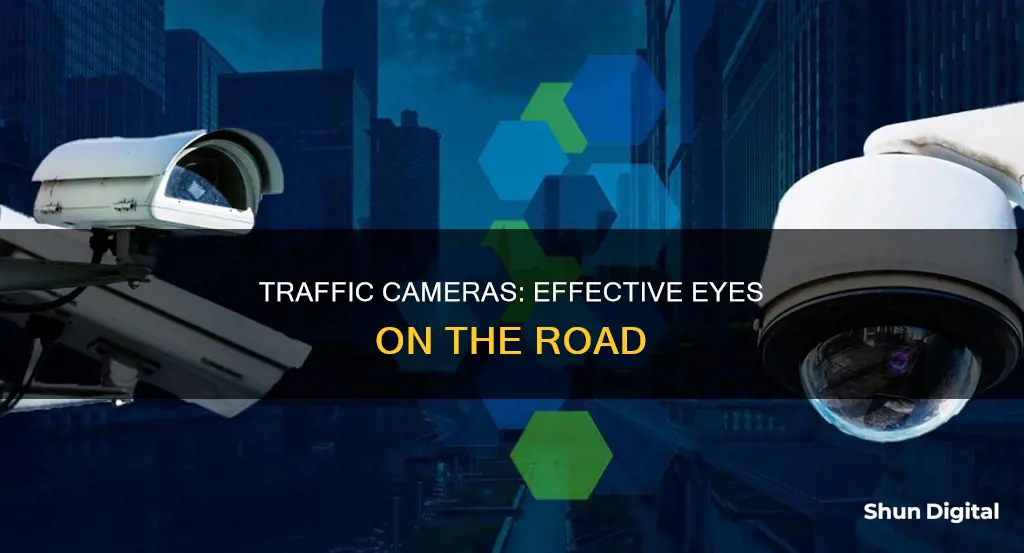
Traffic cameras are more effective than surveillance cameras in certain contexts because they are designed to monitor and manage traffic flow. Strategically placed at intersections, highways, and other key locations, they capture real-time footage of vehicles, detect traffic violations, and enhance road safety. They possess specialized features for traffic analysis, such as license plate recognition, speed detection, and red-light violation detection, enabling authorities to efficiently monitor, control, and manage traffic flow. Surveillance cameras, on the other hand, are typically used for broader security purposes and lack the same level of specialized functionality for traffic management.
| Characteristics | Values |
|---|---|
| Purpose | Traffic cameras are designed to monitor and manage traffic flow, enforce traffic laws, and improve road safety. Surveillance cameras are used for broader security purposes, such as monitoring public spaces or private property. |
| Functionality | Traffic cameras have specialized features for traffic analysis, such as license plate recognition, speed detection, and red light violation detection. Surveillance cameras may not have the same level of specialized functionality. |
| Placement | Traffic cameras are strategically placed at intersections, highways, and other key locations to capture real-time footage of vehicles. Surveillance cameras may be placed in a variety of locations depending on their purpose. |
| Data | Traffic cameras provide valuable data for traffic management, planning, and infrastructure development. This data can be used to improve traffic flow, address congestion, and enhance road safety. |
| Integration | Traffic cameras can be integrated with traffic management systems, allowing for real-time monitoring, proactive traffic management, and the utilization of advanced technologies, such as artificial intelligence. |
What You'll Learn

Traffic cameras are strategically placed to monitor traffic flow
The strategic placement of traffic cameras at common congestion points on highways, freeways, and major arteries provides valuable information on traffic flow. By analysing traffic patterns, transportation departments can make informed decisions about future road development and construction work. Additionally, the presence of cameras can help discourage traffic violations and encourage safe driving habits.
Traffic cameras are also beneficial for gathering data on peak traffic times and accident hotspots. This data can be used to improve traffic management and reduce the risk of collisions. In some cases, rapid deployment pole cameras can be moved quickly to new locations, providing maximum coverage and flexibility in surveillance.
Furthermore, traffic cameras play a crucial role in crime prevention and investigation. They can be used to monitor temporary road construction sites, protect workers, and safeguard valuable equipment and tools. The footage captured by these cameras can also assist law enforcement agencies in investigating various crimes, such as traffic violations, illegal dumping, and other incidents.
Overall, the strategic placement of traffic cameras to monitor traffic flow has a positive impact on road safety, traffic management, and crime prevention. By utilising advanced technology and providing valuable data, traffic cameras help create a safer and more efficient transportation network for all road users.
The Rebel T6 Camera Battery: How Long Does It Last?
You may want to see also

They have specialised features for traffic analysis
Traffic cameras have specialised features for traffic analysis that surveillance cameras lack. These features enable traffic cameras to be more effective than surveillance cameras.
Traffic cameras are often equipped with automatic number-plate recognition (ANPR) technology. ANPR cameras can be used to detect average speeds, identify vehicles, and track vehicle movements. This technology can be used to detect motoring offences such as speeding, running red lights, or unauthorised use of bus lanes. For example, bus lane enforcement cameras use ANPR to compare the vehicle registration plate with a list of approved vehicles and record images of other vehicles.
Another specialised feature of traffic cameras is their ability to monitor traffic flow and congestion. Cameras can be placed at common congestion points to provide information on the causes and severity of poor traffic flow. This data can be used to improve traffic management and reduce congestion.
In addition, traffic cameras can be used for enhanced data gathering. For instance, a state transportation department can use mobile surveillance cameras to monitor traffic flows on roads and major arteries. The information obtained can include details of peak traffic times and accident hotspots, which can then be used to inform future road development and construction work.
Furthermore, some traffic cameras have built-in analytics systems that can automatically detect traffic build-up and issue alerts, allowing for this information to be shared with road users via traffic warning signs. This helps to improve traffic flow and reduce the risk of accidents.
Overall, the specialised features of traffic cameras for traffic analysis, such as ANPR technology, congestion monitoring, and data gathering, contribute to their effectiveness in improving road safety and reducing accidents.
How to Fight Camera-Based Speeding Tickets in Tennessee
You may want to see also

They integrate with traffic management systems
Traffic cameras are more effective than surveillance cameras due to their integration with Traffic Management Systems. These systems are designed to monitor and manage traffic flow, and the integration of traffic cameras enhances their effectiveness in several ways.
Firstly, traffic cameras provide real-time data on traffic conditions, allowing traffic management systems to make informed decisions and take immediate action. By capturing live footage of roadways, traffic cameras can detect congestion, accidents, or incidents that may disrupt traffic flow. This information can then be used by traffic management systems to adjust signal timings, reroute traffic, or dispatch emergency services. This integration enables a proactive approach to managing traffic, reducing delays and improving overall efficiency.
Additionally, traffic cameras can be equipped with advanced technologies such as automatic license plate recognition (ALPR) and video analytics. ALPR technology can identify and track vehicles, enabling traffic management systems to monitor traffic patterns, identify traffic violators, or detect stolen vehicles. Video analytics can analyze footage in real-time, detecting anomalies or unusual behaviour that may require immediate attention. These technologies enhance the surveillance capabilities of traffic cameras, allowing for more effective monitoring and management of traffic.
The integration of traffic cameras with emerging technologies such as artificial intelligence (AI) and machine learning further increases their potential. AI-powered algorithms can analyze vast amounts of video data, identifying patterns and predicting traffic conditions with greater accuracy. This enables traffic management systems to anticipate congestion, plan for events, and optimize traffic flow in real-time. Machine learning algorithms continuously improve their performance by learning from historical data, leading to more efficient traffic management over time.
In conclusion, traffic cameras are more effective than surveillance cameras due to their integration with Traffic Management Systems. This integration enables real-time monitoring, proactive traffic management, and the utilization of advanced technologies. As technology continues to advance, the effectiveness of traffic cameras in managing traffic will also continue to improve.
Surveillance Camera Systems: Choosing the Right One for You
You may want to see also

They have improved accuracy in license plate recognition
Traffic cameras are more effective than surveillance cameras due to their improved accuracy in license plate recognition.
License Plate Recognition (LPR) cameras are specifically designed to identify and read license plates accurately. They use advanced algorithms and infrared technology to enhance license plate recognition in various lighting conditions and high speeds. LPR cameras can reliably detect and convert images of license plates into text data, even for vehicles traveling at high speeds. This capability is particularly useful for law enforcement agencies, enabling them to monitor traffic, identify stolen vehicles, and gather evidence.
LPR cameras offer unparalleled accuracy in license plate recognition, with recognition rates of up to 98%. They can automatically identify license plate numbers, tracking the position of the license plate, separating characters, and recognizing them. This process improves security and traffic management efficiency.
Additionally, LPR cameras can be integrated with security systems to control access based on license plate recognition. They can also be used for urban access management, such as in low-emission zones, and for multi-lane monitoring.
The high accuracy of LPR cameras in license plate recognition makes them a valuable tool for security, traffic management, and law enforcement applications.
Troubleshooting Galaxy S5 Camera Focus Issues
You may want to see also

They can be used for multiple purposes
Traffic cameras can be used for multiple purposes, and their benefits extend beyond crime prevention and investigation.
One of the primary uses of traffic cameras is to monitor and manage traffic flow. Cameras can be placed at common congestion points to gather data on traffic patterns, allowing for better traffic management and improved road development. For example, WCCTV's mobile surveillance cameras have built-in 4G LTE transmission technology, providing users with real-time data and video footage to make informed decisions.
Another advantage of traffic cameras is their ability to enhance road safety. They can be used to detect and deter traffic violations such as speeding, red-light running, and illegal turns. These cameras can be linked to an automated ticketing system, helping to enforce traffic rules and reduce accidents. For instance, a study in the British Medical Journal reported that speed cameras effectively reduced accidents and injuries, supporting their wider deployment.
Additionally, traffic cameras can assist in identifying untaxed, uninsured, or stolen vehicles. Automatic Number Plate Recognition (ANPR) technology enables cameras to read license plates and track vehicle whereabouts. This information can be invaluable for criminal investigations and locating wanted individuals.
Traffic cameras also play a role in protecting workers and equipment at road construction sites. The visible presence of cameras can discourage dangerous driving and help ensure the safety of highway workers. The cameras can also monitor valuable materials and equipment, reducing the risk of theft.
Furthermore, traffic cameras can be used to address noise pollution from vehicles. Noise enforcement cameras are triggered when a vehicle's noise level exceeds a pre-set decibel limit, allowing for the identification and prosecution of offenders.
While some may view traffic cameras as a form of "Big Brother" surveillance, their multiple purposes and benefits to law enforcement and road safety management cannot be overlooked.
The Evolution of Cameras: Capturing Light and Moments
You may want to see also
Frequently asked questions
Traffic cameras are designed specifically to monitor and manage traffic flow, and are placed strategically at key locations to capture real-time footage of vehicles and their movements. They are equipped with advanced features such as license plate recognition, speed detection, and red light violation detection, which enable authorities to efficiently monitor and control traffic. Surveillance cameras, on the other hand, are used for broader security purposes and may not have the same specialised functionality for traffic management.
Traffic cameras are primarily used for traffic monitoring and management, while surveillance cameras are typically used for security purposes, such as monitoring public spaces or private property. Traffic cameras have advanced features like license plate recognition and speed detection, which are not usually found in surveillance cameras.
Traffic cameras play a crucial role in enforcing traffic laws, reducing speeding, red-light violations, and improving overall road safety. Studies have shown that speed cameras, for example, can lead to a significant reduction in fatal and serious injury crashes, making roads safer for everyone.
Traffic cameras provide real-time data on traffic conditions, allowing traffic management systems to make informed decisions. They can detect congestion, accidents, or other incidents, and enable authorities to take immediate action to optimise traffic flow and minimise delays.
While traffic cameras are effective in monitoring and managing traffic, they may face limitations in certain situations. For instance, mobile speed cameras can be more challenging to spot as they are not permanently mounted and may be placed on tripods or inside vans. Additionally, some drivers may attempt to avoid detection by using GPS devices or radar jammers.







